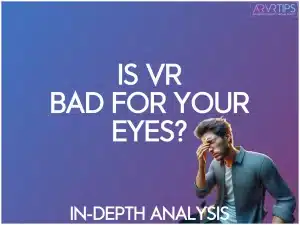Virtual reality (VR) has revolutionized how we interact with digital environments, providing us with immersive experiences that blur the line between the virtual and the real. However, as VR becomes increasingly popular, concerns about its impact on eye health are also rising.
Is VR bad for your eyes?
Are these concerns warranted?
In this blog post, we will dive deep into the potential risks and benefits of VR on eye health, offering insights from both sides of the argument and empowering you to make informed decisions about your VR usage.
Key Takeaways
VR headsets can cause temporary eye discomfort and strain, but not permanent damage.
Eye strain risks can be minimized with proper headset settings and regular breaks.
Consult an eye doctor if lasting problems occur when using VR to ensure good eye health.
Are VR Headsets Bad For Your Eyes?
While virtual reality (VR) technology has opened up a world of immersive experiences, it has also raised concerns regarding its potential impact on eye health. Some users have reported eye strain, dry eyes, and cybersickness after using VR headsets.
However, current research doesn’t suggest that using VR headsets can cause permanent damage to the eyes.
On the other hand, the temporary effects of VR on eye health are well-documented. Prolonged use of VR headsets can lead to eye pain and discomfort. In some cases, visual problems such as digital eye strain.
While these issues are generally not serious, they can be uncomfortable and may deter some individuals from using VR technology.
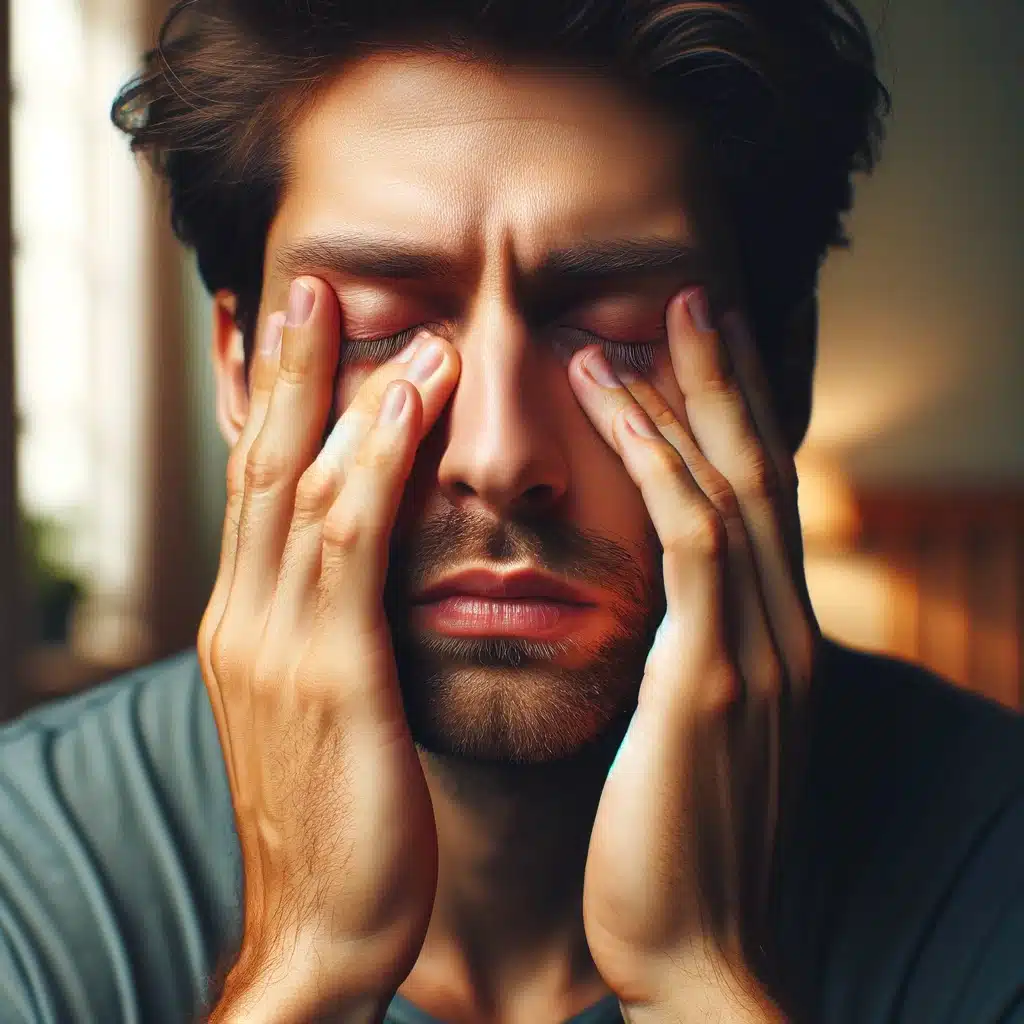
Are Pancake Lenses Worse?
New VR headsets like the Meta Quest 3 and Meta Quest Pro contain pancake-style lenses. They lenses are much thinner than traditional fresnel lenses.
There is no differences in how much eye straight or soreness is caused by these lenses.
Eye Strain in Virtual Reality
Eye strain in VR is a common concern among users. This discomfort can be attributed to the close proximity of the screen to the user’s eyes and the need to focus on a pixelated image.
Another factor that can contribute to eye strain in VR is the “vergence-accommodation conflict.” This conflict occurs when the eyes are still focused on a fixed point, despite converging on something that appears further away, resulting in eye strain.
Following best practices like taking regular breaks and adjusting the VR headset’s settings for optimal comfort can minimize the risk of eye strain.
By being mindful of these factors, users can enjoy the immersive experience of virtual reality while minimizing the potential for eye strain.
Dry Eyes and Decreased Blinking
Another issue with VR headset use is dry eyes, which can result from a decreased blink rate and the heat generated by the device. When users become deeply immersed in a virtual environment, they may forget to blink as frequently as they would in the real world, leading to dry and irritated eyes.
In addition to decreased blinking, the heat produced by VR headsets can contribute to dry eyes. Contact lens wearers, in particular, may be more susceptible to this issue.
Taking breaks during VR sessions and consulting an eye doctor if symptoms persist can help prevent dry eyes and the associated discomfort.
Cybersickness and Visual Discomfort
Cybersickness, a form of motion sickness, is a temporary condition some VR users may experience, characterized by nausea and dizziness. This discomfort arises due to mixed sensory signals, causing the user’s brain to struggle with processing the conflicting information.
70% of VR players have felt nausea and dizziness before!
Although cybersickness can be an unpleasant side effect of VR use, it is generally short-lived and resolves once the user exits the virtual environment, which can be attributed to the challenges in depth perception.
To minimize the risk of cybersickness, users can try starting with less intense VR experiences and gradually increasing the intensity as they become more accustomed to the technology.
Tips for Reducing Eye Strain in VR
While VR technology has the potential to cause eye strain and discomfort, there are several strategies that users can employ to mitigate these risks. Here are some tips:
Take regular breaks to rest your eyes and prevent eye strain.
Utilize blue light filters on your VR headset or device to reduce eye fatigue.
Ensure that your headset is properly fitted and calibrated for your eyes to minimize discomfort.
By following these strategies, you can have a more comfortable and enjoyable VR experience.
Adopting these practices, which can improve hand-eye coordination, can lower the chances of eye strain and other visual problems, enabling users to delve into the virtual world without jeopardizing their eye health.
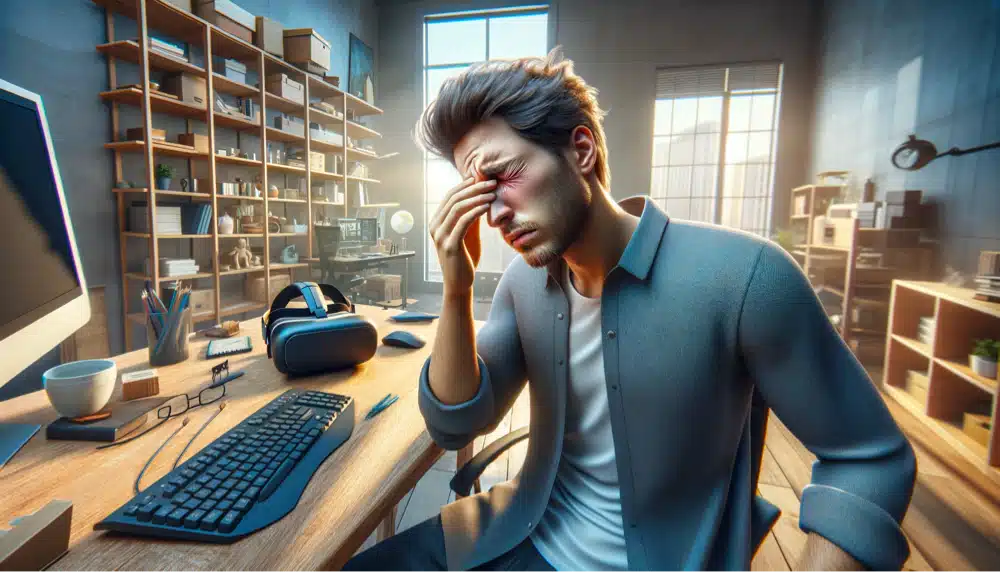
Taking Regular Breaks
One of the most effective ways to alleviate eye strain and fatigue during VR use is to take regular breaks. It is advised to take a 10-15 minute break for every 30 minutes of VR use.
During these breaks, users should focus on objects at least 20 feet away, allowing the eyes to relax and refocus.
Incorporating regular breaks into VR sessions can help users reduce the risk of eye strain and other visual problems associated with prolonged exposure to digital screens.
This not only promotes a more comfortable VR experience but also helps maintain overall eye health.
Blue Light Filters and Screen Adjustments
Another strategy for reducing eye strain during VR use is to utilize blue light filters and make screen adjustments. Blue light filters work by blocking or reducing the amount of blue light emitted from the display, which is known to cause eye strain and disrupt sleep patterns.
By filtering out blue light, these filters can help decrease eye strain during VR use.
In addition to blue light filters, making screen adjustments can help minimize eye strain. Calibrating the display settings and taking frequent breaks during VR sessions can create a more comfortable virtual experience.

Proper VR Headset Fit and Calibration
A proper fit and calibration of the VR headset are key to reducing eye strain and discomfort. A well-fitted headset prevents light leakage and ensures the display is properly aligned with your eyes, minimizing the need for excessive eye movement and decreasing the strain on your eye muscles.
To achieve a proper fit, users should:
Adjust the headset’s straps
Position the screen correctly against the eyes
Calibrate the interpupillary distance (IPD) to optimize the VR experience and reduce eye strain.
VR Technology and Children’s Eye Health
While VR technology provides many immersive experiences for all ages, its potential impact on children’s eye health warrants consideration.
Prolonged VR use may pose risks for young users, including early myopia and digital eye strain. However, by following guidelines and encouraging healthy habits, parents and caregivers can help mitigate these risks and ensure a safe VR experience for children.
Parents and caregivers can protect their children’s vision while allowing them to enjoy the benefits of this exciting technology by considering the potential risks associated with VR use in children and promoting strategies for eye health.
Age Recommendations and Guidelines
VR headset manufacturers generally recommend that their devices be used by children aged 12 and above. This is to ensure the safety of the child while using such technology. This age recommendation is based on factors such as:
Physical and cognitive development
Potential health risks
Industry guidelines
The content of VR experiences
Parents and caregivers can help ensure a safe and enjoyable VR experience for their children by adhering to these age recommendations. It is important to monitor and supervise children’s VR use, especially for younger users, to prevent potential eye strain and other visual problems.
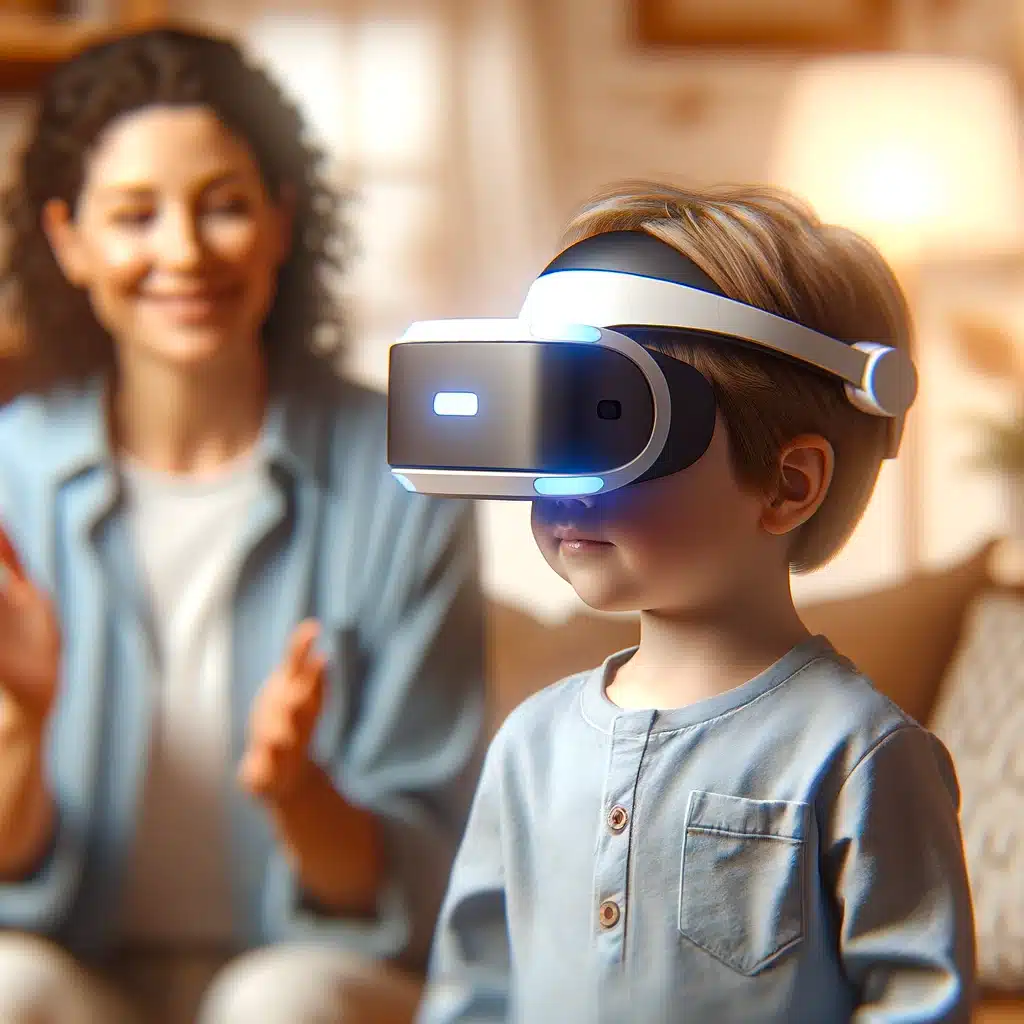
Potential Risks for Young Users
Potential risks for young users of VR technology include early myopia and digital eye strain. Prolonged use of VR headsets can cause eye strain and lead to focusing on pixelated screens, which can impact vision development and potentially contribute to myopia progression.
Research suggests that extensive screen time and reduced time spent outdoors may result in earlier and more rapid onset of myopia in young users.
Parents and caregivers can limit these potential risks by monitoring how much time children spend using VR headsets and encouraging non-screen-based pursuits.
Encouraging Healthy Habits
It is essential for parents and caregivers to encourage healthy habits while using VR technology. Taking breaks and limiting screen time can help protect children’s eyes during VR use.
Additionally, promoting a balanced approach to technology use can further support overall eye health.
Parents and caregivers can safeguard their children’s vision and ensure a safe, enjoyable, and educational experience with this cutting-edge technology by:
fostering healthy habits in children
monitoring their VR use
encouraging regular comprehensive eye examinations
Therapeutic Uses of VR for Vision Improvement
In addition to its recreational applications, VR technology has shown promise in the therapeutic realm for vision improvement. VR has been utilized to treat conditions such as amblyopia, or lazy eye, and to assist vision-impaired individuals in enhancing their sight.
By harnessing the immersive nature of VR, these treatments can provide targeted and engaging therapies that may lead to improved visual outcomes.
As research and innovation in this area continue, VR technology has the potential to revolutionize the way we approach vision therapy.
Treating Amblyopia (Lazy Eye)
VR technology has been shown to enhance visual acuity in adult amblyopia and is currently under development for children with lazy eyes. By offering immersive and engaging visual experiences, VR-based treatments can provide targeted stimulation and promote visual development. This will reduce blurry vision.
As research in this area progresses, VR technology could become an increasingly valuable tool in treating amblyopia.
Assisting Vision-Impaired People
VR headsets can also be crucial in assisting visually impaired individuals when combined with other treatments. By offering immersive visual experiences tailored to the individual’s specific vision requirements, VR technology can help to improve visual acuity and overall quality of life for those with vision impairments.
As the field of VR continues to evolve, we can expect to see further innovations and advancements in the development of treatments for vision-impaired individuals.
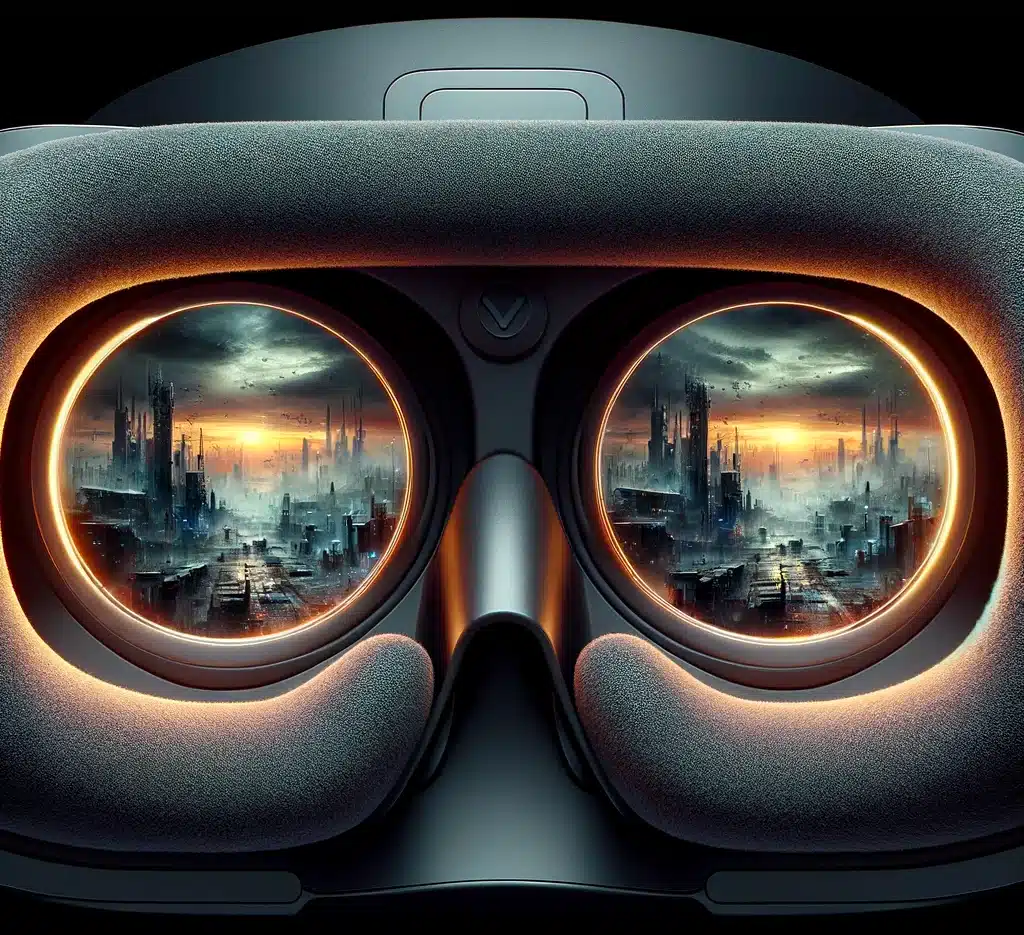
When to Consult an Eye Doctor
While temporary eye discomfort and strain may be common after using VR, it is important to consult an eye doctor if lasting eye problems occur. There may be an underlying condition that requires attention. By seeking medical advice when necessary, users can ensure their eye health is maintained, and any potential issues are addressed promptly.
In conclusion, it is essential for VR users to be aware of the potential risks and benefits associated with this technology. They should make sure to take the necessary precautions to protect their eye health.
By following best practices and consulting an eye doctor when needed, users can enjoy the immersive world of virtual reality while safeguarding their vision.
The Future of VR and Eye Health
As VR technology advances, its impact on eye health remains an area of ongoing research and development. Innovations in headset design, along with clinical research and studies, will play a significant role in shaping the future of VR and eye health.
With a growing understanding of the potential risks and benefits of VR technology, we can expect to see further advancements in the field, offering new possibilities for both recreational and therapeutic applications.
As VR technology evolves, users must stay informed and prioritize their eye health to guarantee a safe and enjoyable experience.
Innovations in VR Headset Design
Manufacturers are actively working to improve virtual reality headsets to mitigate eye strain and discomfort. Recent innovations in VR headset design include incorporating eye-tracking technology, high-resolution displays, and comfortable designs that minimize eye strain and maximize user comfort.
With ongoing advancements in VR technology, we anticipate further improvements in design and functionality that will offer users a more comfortable and visually pleasing experience while mitigating the potential for eye strain.
Clinical Research and Studies
Ongoing clinical research and studies are crucial for better understanding the long-term effects of VR on eye health. As researchers continue to explore the potential risks and benefits associated with VR use, their findings will help inform the development of new treatments, guidelines, and best practices for maintaining eye health in virtual reality.
Staying current with the latest research allows users to make informed decisions about their VR usage, preserving their eye health while they explore the immersive world of virtual reality.
So, Is VR Bad For Your Eyes?
VR technology has the potential to transform our lives in countless ways, offering immersive experiences that enrich both our recreational and therapeutic pursuits. However, it is essential to be mindful of the potential risks associated with VR use, particularly regarding eye health.
By understanding the potential risks, following best practices, and consulting an eye doctor when necessary, users can navigate the virtual world with confidence, knowing that they are protecting their vision and ensuring a safe and enjoyable experience.
Frequently Asked Questions (FAQs)
Does VR damage your eyesight?
Prolonged use of VR headsets can cause short-term eye strain and discomfort, as well as blurred vision, twitching, and dry eyes. There is no evidence to suggest that it causes any long-term damage, but it is recommended that children under 13 avoid using VR devices and that everyone uses them in moderation.
How long should you play VR a day?
It is recommended to limit time spent in VR to 10-15 minutes at a time. Take a break every 30 minutes and avoid playing 1-2 hours before bedtime, as this may disrupt your sleep. Prolonged use may also cause eyestrain or difficulty identifying where things are in the physical world.
Is VR bad for kids?
VR can be a positive experience for children if used in moderation and under parental supervision. However, there are potential risks associated with its use, such as eye strain, neck strain, and tripping or falling due to not being able to see their surroundings. It is important that parents monitor children’s use of VR devices and ensure they use them safely.
Can VR technology help improve vision in people with certain eye conditions?
VR technology has proven to be effective in treating eye conditions like amblyopia, offering patients an opportunity to improve their vision.
When should I consult an eye doctor after using VR?
It is advised to consult an eye doctor if any persistent eye issues develop after using VR, as it may indicate an underlying condition.

